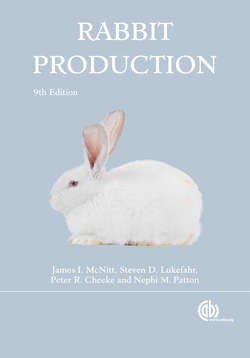Читать книгу Rabbit Production - James I McNitt - Страница 65
На сайте Литреса книга снята с продажи.
Tattooing and Ear Tags
ОглавлениеAn efficient, permanent system for identification is a necessity. Tattooing figures or letters, or a combination of the two, in the rabbit’s ear does not disfigure it, is permanent, and is easily accomplished. When young are being fostered, a hand tattoo needle is satisfactory for making one or more dots in each kit’s ear so the transferred young can be identified. It is also used by many breeders for the regular tattooing work in the rabbitry; others prefer the plier or tongs with removable figures and letters. After the inside of the ear is thoroughly cleaned with alcohol, either instrument may be used to perforate the inner surface of the ear. Tattoo ink or India ink should be rubbed into the perforations immediately (Fig. 5.15). The registration number for purebred stock is usually tattooed in the right ear and the rabbit’s individual mark or number in the left ear. A tattoo box that has movable parts so it can be adjusted to different sized rabbits (Fig. 4.18) holds the animal steady so one person can do the tattooing.
Fig. 5.15. A permanent identification mark tattooed in a rabbit’s ear (Courtesy of J.I. McNitt)
Rabbits can also be identified by the use of ear tags. These are produced as wing bands for chickens and are available from poultry supply houses. They are easily inserted using a simple tool (Fig. 5.16). Ear tags are sometimes lost, so identification is not as permanent as with tattoos. One method to make eartags less vulnerable to loss is to fold the ear and insert the tag halfway across the fold. When the ear is straightened out, the tag will be in the middle of the ear and have less chance of snagging on something and tearing out. For temporary identification, marking the ears with a felt-tipped pen is useful.
Fig. 5.16. An ear tag for easy identification. (Courtesy of OSU Rabbit Research Center)
